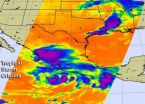(Press-News.org) CAMBRIDGE, MA -- Children learn a great deal about the world from their own exploration, but they also rely on what adults tell them. Studies have shown that children can figure out when someone is lying to them, but cognitive scientists from MIT recently tackled a subtler question: Can children tell when adults are telling them the truth, but not the whole truth?
Led by Laura Schulz, the Class of 1943 Career Development Associate Professor of Cognitive Science, the researchers found that not only can children make this distinction, but they can also compensate for incomplete information by exploring more on their own.
Determining whom to trust is an important skill to learn at an early age because so much of our knowledge about the world comes from other people, says Hyowon Gweon, an MIT postdoc and lead author of a paper describing the findings in the journal Cognition.
"When someone provides us information, we not only learn about what is being taught; we also learn something about that person. If the information is accurate and complete, then you might also trust that person in the future," Gweon says. "But if this person has taught you something wrong, has made a mistake, or has omitted something that's important for you to know, then you might want to suspend your trust, be skeptical of the information he provides in the future, and even seek other sources of information."
The study builds on a 2011 paper in which Schulz, Gweon, and others investigated how children behave when a teacher explains only one function of a toy that can do four different things. They found that these children spent most of their time exploring only the function the teacher had demonstrated (the toy squeaks when a yellow tube is pulled), assuming that was the only thing it could do. However, children who received no instruction spent more time exploring all of the toy's features and ended up discovering more of them.
Trustworthy or not?
In the new study, Gweon wanted to investigate what the children thought of the teacher who did not fully explain what the toy could do.
"Previous studies about children's trust in informants or teachers focused on whether children distinguish, and learn differentially from, someone who says something false from someone who's telling the truth," she says. "Going beyond those sensitivities to truth and falseness, what I wanted to see in this study is whether children are also sensitive to someone who's telling the truth but not the whole truth; someone who didn't tell them everything that they ought to know."
In the first experiment, children aged 6 and 7 were given a toy to explore on their own until they discovered all of its functions. One group of children received a toy that had four buttons, each of which activated a different feature — a windup mechanism, LED lights, a spinning globe, and music — while the other group was given a toy that looked nearly identical but had only one button, which controlled the windup mechanism. Then the children watched as a "teacher" puppet demonstrated the toy to a "student" puppet. For both toys, the teacher's instruction was the same: He demonstrated only the windup mechanism.
After the demonstration, the children were asked to rate how helpful the teacher was, using a scale from 1 to 20. Even though the teacher always demonstrated just the windup mechanism, children who knew the toy had three more undemonstrated functions gave much lower ratings than children who knew it was the toy's only function.
The second experiment began the same way, with the children exploring the toy, then seeing either a full or incomplete demonstration of its functions. However, in this study, the teacher then brought out a second toy. Although this toy had four functions, the teacher demonstrated only one.
Children who had previously seen a demonstration they knew to be incomplete explored the toy much more thoroughly than children who had seen a complete demonstration, suggesting that they did not trust the teacher to be fully informative.
"This shows that children are not just sensitive to who's right or wrong," Gweon says. "Children can also evaluate others based on who's providing information that is enough or not enough for accurate inference. They can also adjust how they learn from a teacher in the future, depending on whether the teacher has previously committed a sin of omission or not."
Too much information
In another recent study, Gweon and Schulz investigated the flip side of this issue: how children react to teachers who present too much information, rather than too little. In a paper to be presented at the annual conference of the Cognitive Science Society in July, they found that children prefer teachers who do not spend time offering information that the children already know, or that they could have inferred from what they already know.
"These studies are the first steps toward understanding just how rich children's understanding of the world is," Gweon says. "Children are trying to bring together all kinds of information in order to make rational decisions about how to learn about the world, and who to go to for more information, while being also mindful of the cost related to learning, such as time and effort."
INFORMATION:
The research was funded by the National Science Foundation, the John Templeton Foundation, the James S. McDonnell Foundation, and an Ewha Womans University 21st Century Fellowship.
Written by Anne Trafton, MIT News Office
The whole truth
Children can tell when a teacher commits 'sins of omission'
2014-06-10
ELSE PRESS RELEASES FROM THIS DATE:
Wolves in wolves' clothing not all the same
2014-06-10
New research co-authored by University of Calgary alumna Erin Navid provides evidence that British Columbia's mainland wolves and coastal wolves are more distinct than previously believed.
The research, published today in the scientific journal BMC Ecology, affirms what Chester Starr, an elder from the Heiltsuk First Nation on BC's remote west coast, and his people have always known: 'Timber Wolves' occupy the mainland of the British Columbia coast and 'Coastal Wolves' live on the nearby islands. Starr's insight provided motivation for the study.
"What makes this study ...
Coho salmon: Pinks' and chums' eating cousin
2014-06-10
Newly published research co-authored by scientists at Simon Fraser University and the Raincoast Conservation Foundation shows juvenile coho salmon benefit from dining on the distant remains of their spawning pink and chum cousins.
While juvenile coho salmon feed directly on spawning pink and chum salmon carcasses and eggs, even coho with no direct contact with spawning pink and chum benefit from their nutrient contributions to stream ecosystems.
The new research shows that juvenile coho abundance is up to three times higher in streams with abundant pink and chum compared ...
Genetics reveal that reef corals and their algae live together but evolve independently
2014-06-10
New research reveals that Caribbean corals and the algae that inhabit them form a remarkably stable relationship -- new knowledge that can serve as an important tool in preserving and restoring vital reef-building corals. A scientific paper describing these new findings by a team of marine biologists at Penn State University will be published as a cover article in Molecular Ecology on 10 June 2014.
Coral reefs are important for protecting shorelines, providing seafood, and generating millions of dollars in recreation revenue each year, but rising water temperatures due ...
Miriam Hospital study shows how to make statewide health campaigns more effective
2014-06-10
PROVIDENCE, R.I. - Researchers from The Miriam Hospital have found that adding evidence-based weight loss strategies to a statewide wellness campaign improves weight loss outcomes among participants. The study and its findings are published online in advance of print in the American Journal of Public Health.
Lead researcher Tricia Leahey, Ph.D., and her colleagues chose to conduct a study among participants in Rhode Island's annual, three-month statewide health campaign. Called Shape Up Rhode Island (SURI), the campaign was founded in 2005 and takes a grass roots approach ...
NASA sees Tropical Storm Christina's birth and severe weather in US South
2014-06-10
NASA's Aqua satellite captured a picture of newborn Tropical Storm Cristina on June 10, marking the birth date of the Eastern Pacific Ocean's third tropical storm of the season. The same image showed the severe weather affecting the south central U.S.
Although not at the coastline, the National Hurricane Center said that Cristina is near enough to cause dangerous surf conditions.
According to the National Hurricane Center (NHC), swells generated by Cristina are affecting portions of the south-central coast of western Mexico. These swells will likely continue through ...
NASA-NOAA's Suomi NPP satellite spots Arabian Sea tropical cyclone
2014-06-10
Tropical Cyclone 02A formed in the Arabian Sea as NASA-NOAA's Suomi NPP satellite passed overhead and captured a visible photo of the storm, spotting strongest storms south of its center.
On June 10 at 08:21 UTC (4:21 a.m. EDT), when Suomi NPP passed over 02A, the Visible Infrared Imaging Radiometer Suite (VIIRS) instrument aboard captured a visible image of the storm. VIIRS collects visible and infrared imagery and global observations of land, atmosphere, cryosphere and oceans.
In the image, Tropical Storm 02A appeared slightly elongated but satellite data shows that ...
NASA's SDO sees a summer solar flare
2014-06-10
The sun emitted a significant solar flare, peaking at 7:42 a.m. EDT on June 10, 2014. NASA's Solar Dynamics Observatory – which typically observes the entire sun 24 hours a day -- captured images of the flare.
Solar flares are powerful bursts of radiation. Harmful radiation from a flare cannot pass through Earth's atmosphere to physically affect humans on the ground. However, when intense enough, they can disturb the atmosphere in the layer where GPS and communications signals travel.
To see how this event may affect Earth, please visit NOAA's Space Weather Prediction ...
Inside the adult ADHD brain
2014-06-10
CAMBRIDGE, MA -- About 11 percent of school-age children in the United States have been diagnosed with attention deficit hyperactivity disorder (ADHD). While many of these children eventually "outgrow" the disorder, some carry their difficulties into adulthood: About 10 million American adults are currently diagnosed with ADHD.
In the first study to compare patterns of brain activity in adults who recovered from childhood ADHD and those who did not, MIT neuroscientists have discovered key differences in a brain communication network that is active when the brain is at ...
Mammography has led to fewer late-stage breast cancers, U-M study finds
2014-06-10
ANN ARBOR, Mich. — In the last 30 years, since mammography was introduced, late-stage breast cancer incidence has decreased by 37 percent, a new study from the University of Michigan Comprehensive Cancer Center finds.
The analysis takes into account an observed underlying trend of increased breast cancer incidence present since the 1940s, a sort of inflation rate for breast cancer.
Researchers looked at early-stage and late-stage breast cancer diagnoses between 1977-1979, before mammography became popular, and compared it to diagnoses between 2007-2009. Based on trends ...
A plan to share the carbon budget burden
2014-06-10
PROVIDENCE, R.I. [Brown University] — Climate change is an issue of urgent international importance, but for 20 years, the international community has been unable to agree on a coordinated way to reduce greenhouse gas emissions. In a "Perspective" piece published in the June issue of Nature Climate Change, J. Timmons Roberts, the Ittleson Professor of Environmental Studies and Sociology, proposes a four-step compromise toward emissions reduction that offers "effectiveness, feasibility, and fairness."
Their proposal comes as another major United Nations meeting on climage ...
LAST 30 PRESS RELEASES:
Why nail-biting, procrastination and other self-sabotaging behaviors are rooted in survival instincts
Regional variations in mechanical properties of porcine leptomeninges
Artificial empathy in therapy and healthcare: advancements in interpersonal interaction technologies
Why some brains switch gears more efficiently than others
UVA’s Jundong Li wins ICDM’S 2025 Tao Li Award for data mining, machine learning
UVA’s low-power, high-performance computer power player Mircea Stan earns National Academy of Inventors fellowship
Not playing by the rules: USU researcher explores filamentous algae dynamics in rivers
Do our body clocks influence our risk of dementia?
Anthropologists offer new evidence of bipedalism in long-debated fossil discovery
Safer receipt paper from wood
Dosage-sensitive genes suggest no whole-genome duplications in ancestral angiosperm
First ancient human herpesvirus genomes document their deep history with humans
Why Some Bacteria Survive Antibiotics and How to Stop Them - New study reveals that bacteria can survive antibiotic treatment through two fundamentally different “shutdown modes”
UCLA study links scar healing to dangerous placenta condition
CHANGE-seq-BE finds off-target changes in the genome from base editors
The Journal of Nuclear Medicine Ahead-of-Print Tip Sheet: January 2, 2026
Delayed or absent first dose of measles, mumps, and rubella vaccination
Trends in US preterm birth rates by household income and race and ethnicity
Study identifies potential biomarker linked to progression and brain inflammation in multiple sclerosis
Many mothers in Norway do not show up for postnatal check-ups
Researchers want to find out why quick clay is so unstable
Superradiant spins show teamwork at the quantum scale
Cleveland Clinic Research links tumor bacteria to immunotherapy resistance in head and neck cancer
First Editorial of 2026: Resisting AI slop
Joint ground- and space-based observations reveal Saturn-mass rogue planet
Inheritable genetic variant offers protection against blood cancer risk and progression
Pigs settled Pacific islands alongside early human voyagers
A Coral reef’s daily pulse reshapes microbes in surrounding waters
EAST Tokamak experiments exceed plasma density limit, offering new approach to fusion ignition
Groundbreaking discovery reveals Africa’s oldest cremation pyre and complex ritual practices
[Press-News.org] The whole truthChildren can tell when a teacher commits 'sins of omission'





